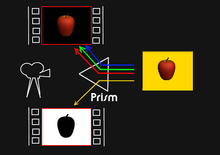This article needs additional citations for verification. (September 2008) |

The sodium vapor process (occasionally referred to as yellowscreen) is a photochemical film technique for combining actors and background footage. It originated in the British film industry in the late 1950s and was used extensively by Walt Disney Productions in the 1960s and 1970s as an alternative to the more common bluescreen process. Wadsworth E. Pohl is credited with the invention or development of both of these processes (Patent US3133814A[1]), and received (with Ub Iwerks and Petro Vlahos) an Academy Award in 1965 for the sodium vapor process as used in the film Mary Poppins.[2][3][4][5]
- ^ Patent US3133814A https://patents.google.com/patent/US3133814?oq=WADSWORTH+E.+POHL
- ^ Brosnan, John (1976). Movie Magic. New American Library. p. 111.
- ^ Smith, Alvy Ray (August 15, 1995). "Alpha and the History of Digital Compositing" (PDF). Retrieved January 8, 2012.
- ^ "Academy Awards Database". Archived from the original on July 11, 2012. Retrieved January 9, 2012.
- ^ Jackman, John (2007). Bluescreen compositing: a practical guide for video & moviemaking. Focal Press. p. 13. ISBN 978-1-57820-283-6.
